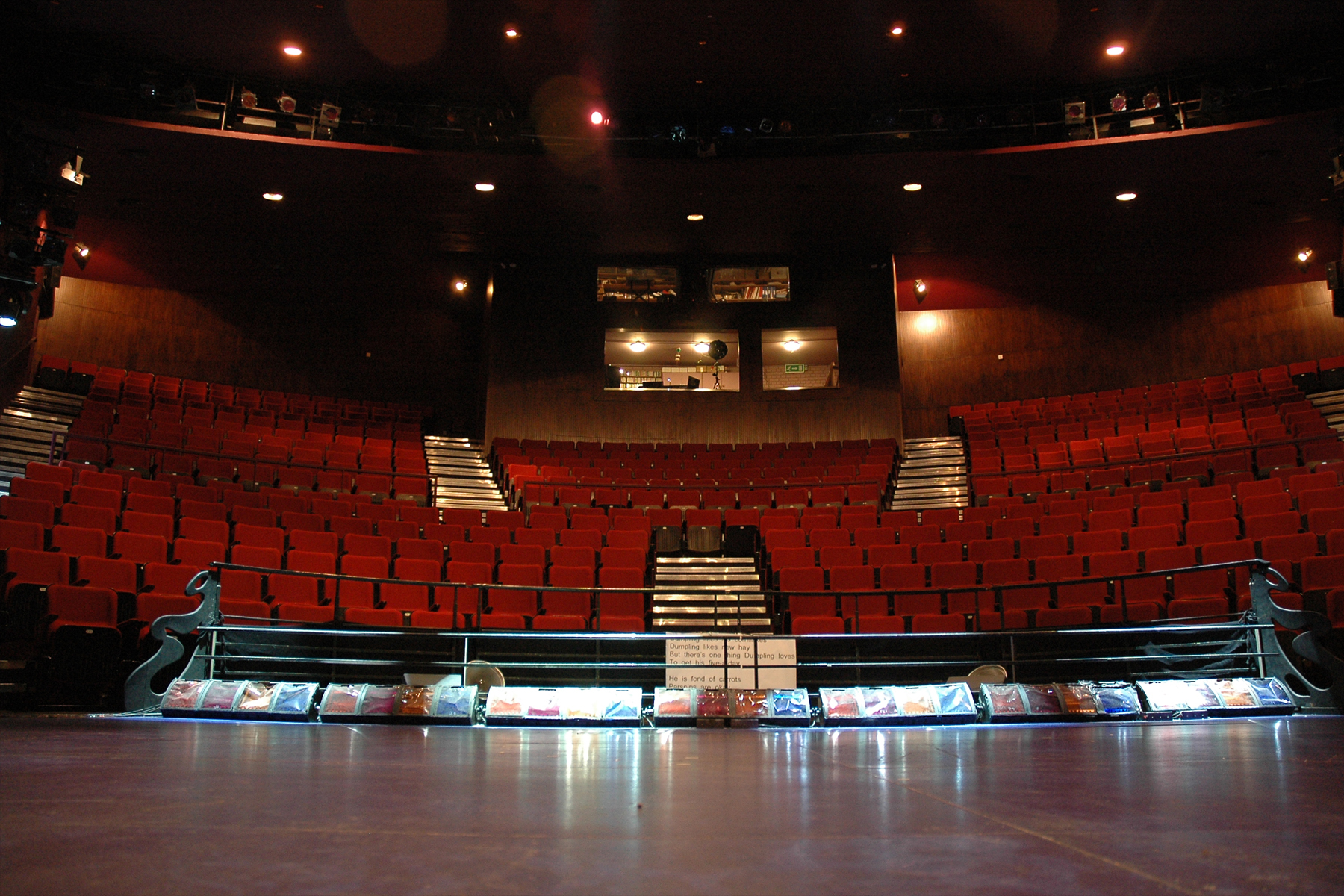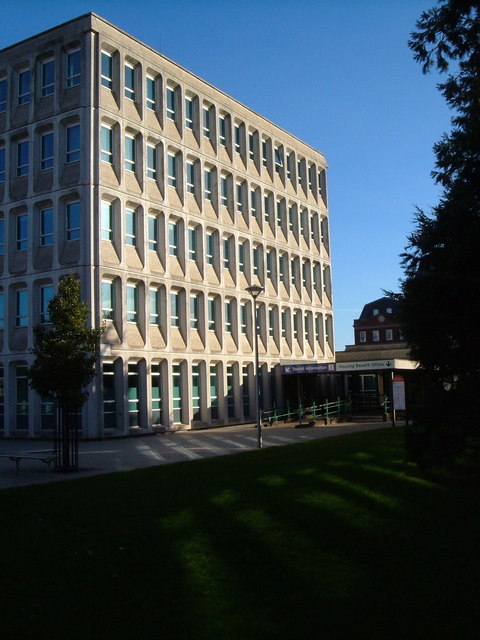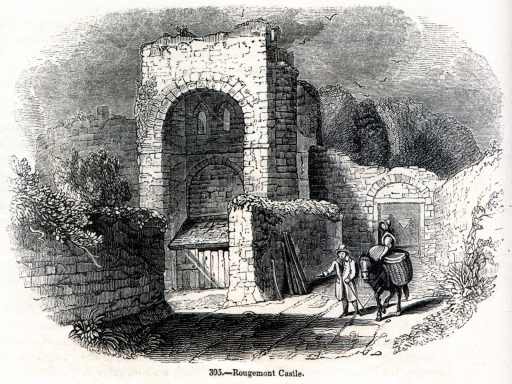|
Rougemont Gardens
Rougemont Gardens is an ornamental open space adjacent to Rougemont Castle in the city of Exeter, Devon, England. It is Grade II listed in the National Register of Historic Parks and Gardens. Originally part of the defences of the castle, it was converted into a garden in the late 18th century, and purchased by the city council in 1912. Boundaries The gardens are bounded on the north-west by the city wall with Northernhay Gardens beyond, and on the north-east by the castle wall with Athelstan's Tower at the junction of the two walls. The eastern boundary is at Castle Street with the early Norman gatehouse of the castle at the top and Rougemont House below. On the south the boundary is formed by Exeter City Central Library and on the south-east by the Phoenix Arts Centre and the Royal Albert Memorial Museum. History The site was originally part of William the Conqueror's defences for Rougemont Castle during the Norman Conquest of England. When William ordered the construction of ... [...More Info...] [...Related Items...] OR: [Wikipedia] [Google] [Baidu] |
Rougemont Gardens, Exeter - Geograph
Rougemont or de Rougemont may refer to: Places * Rougemont, Quebec, Canada **Rougemont Airport **Mont Rougemont, part of the Monteregian Hills * Rougemont, Côte-d'Or, France * Rougemont, Doubs, France * Rougemont-le-Château, Territoire de Belfort, France ** Château de Rougemont * Rougemont, Switzerland * Rougemont, North Carolina, U.S. * Rougemont Castle, in Exeter, Devon **Rougemont Gardens * Rougemont Castle, Weeton, in North Yorkshire, England * Rougemont – Chanteloup railway station in the Rougemont neighbourhood of Sevran, Paris, France * Rougemont School, in Llantarnam, Wales People * Denis de Rougemont (1906–1985), a Swiss writer and cultural theorist * Louis de Rougemont (1847–1921), a Swiss explorer * Marc de Rougemont (born 1972), a French rugby player * Michel-Nicolas Balisson de Rougemont (1781–1840), a French writer Other uses * ''Rougemont'', later ''Bessemer'', a GWR 3031 Class locomotive See also * * *Rugemont Castle, in Ridgmont, Bedfordshire, E ... [...More Info...] [...Related Items...] OR: [Wikipedia] [Google] [Baidu] |
John Norden's 1617 Plan Of Rougemont Castle
John is a common English name and surname: * John (given name) * John (surname) John may also refer to: New Testament Works * Gospel of John, a title often shortened to John * First Epistle of John, often shortened to 1 John * Second Epistle of John, often shortened to 2 John * Third Epistle of John, often shortened to 3 John People * John the Baptist (died c. AD 30), regarded as a prophet and the forerunner of Jesus Christ * John the Apostle (lived c. AD 30), one of the twelve apostles of Jesus * John the Evangelist, assigned author of the Fourth Gospel, once identified with the Apostle * John of Patmos, also known as John the Divine or John the Revelator, the author of the Book of Revelation, once identified with the Apostle * John the Presbyter, a figure either identified with or distinguished from the Apostle, the Evangelist and John of Patmos Other people with the given name Religious figures * John, father of Andrew the Apostle and Saint Peter * ... [...More Info...] [...Related Items...] OR: [Wikipedia] [Google] [Baidu] |
Parks And Open Spaces In Devon
A park is an area of natural, semi-natural or planted space set aside for human enjoyment and recreation or for the protection of wildlife or natural habitats. Urban parks are green spaces set aside for recreation inside towns and cities. National parks and country parks are green spaces used for recreation in the countryside. State parks and provincial parks are administered by sub-national government states and agencies. Parks may consist of grassy areas, rocks, soil and trees, but may also contain buildings and other artifacts such as monuments, fountains or playground structures. Many parks have fields for playing sports such as baseball and football, and paved areas for games such as basketball. Many parks have trails for walking, biking and other activities. Some parks are built adjacent to bodies of water or watercourses and may comprise a beach or boat dock area. Urban parks often have benches for sitting and may contain picnic tables and barbecue grills. The largest ... [...More Info...] [...Related Items...] OR: [Wikipedia] [Google] [Baidu] |
Northcott Theatre
The Northcott Theatre is a theatre situated on the Streatham Campus of the University of Exeter, Exeter, Devon, England. It opened in 1967 and was run until 2010 by the Northcott Theatre Foundation, when the company ceased operating after a period in administration. The theatre is now known as Exeter Northcott Theatre and became a registered charity (no. 1151620) in June 2013. History The Northcott is the seventh building in Exeter to be used as a theatre. In 1962, the Theatre Royal, Exeter, was demolished to be replaced by an office block; however, there were many people in Exeter who were determined that the city should not be without a theatre for very long. Early in 1962, Mr George Vernon Northcott (1891-1963) had started negotiations with the board of directors of the Theatre Royal with the view to "saving" the theatre, and its re-creation as a theatre and arts centre. A small group from the University of Exeter prepared a memorandum explaining how they saw the Theatre Ro ... [...More Info...] [...Related Items...] OR: [Wikipedia] [Google] [Baidu] |
Scheduled Monument
In the United Kingdom, a scheduled monument is a nationally important archaeological site or historic building, given protection against unauthorised change. The various pieces of legislation that legally protect heritage assets from damage and destruction are grouped under the term "designation." The protection provided to scheduled monuments is given under the Ancient Monuments and Archaeological Areas Act 1979, which is a different law from that used for listed buildings (which fall within the town and country planning system). A heritage asset is a part of the historic environment that is valued because of its historic, archaeological, architectural or artistic interest. Only some of these are judged to be important enough to have extra legal protection through designation. There are about 20,000 scheduled monuments in England representing about 37,000 heritage assets. Of the tens of thousands of scheduled monuments in the UK, most are inconspicuous archaeological sites, but ... [...More Info...] [...Related Items...] OR: [Wikipedia] [Google] [Baidu] |
Listed Building
In the United Kingdom, a listed building or listed structure is one that has been placed on one of the four statutory lists maintained by Historic England in England, Historic Environment Scotland in Scotland, in Wales, and the Northern Ireland Environment Agency in Northern Ireland. The term has also been used in the Republic of Ireland, where buildings are protected under the Planning and Development Act 2000. The statutory term in Ireland is " protected structure". A listed building may not be demolished, extended, or altered without special permission from the local planning authority, which typically consults the relevant central government agency, particularly for significant alterations to the more notable listed buildings. In England and Wales, a national amenity society must be notified of any work to a listed building which involves any element of demolition. Exemption from secular listed building control is provided for some buildings in current use for worship, ... [...More Info...] [...Related Items...] OR: [Wikipedia] [Google] [Baidu] |
Exeter City Council
Exeter City Council is the council and local government of the city of Exeter, Devon. History Proposed unitary authority status The government proposed that the city should become an independent unitary authority within Devon, much like neighbouring Plymouth and Torbay. The statutory orders to set up the unitary authority were passed in Parliament and a new unitary city council was due to start in Exeter on 1 April 2011. However, following the 2010 general election the new government announced in May 2010 that the reorganisation would be blocked. Boundaries The Local Government Boundary Commission for England published its final recommendations in September 2015 for changes to the wards in Exeter. The aim was to reduce the city's high levels in electoral inequality. The number of wards was reduced to 13; each electing three councillors for a total of 39. Following parliamentary approval, it came into effect at the 2016 election. Wards and councillors The wards of the city ... [...More Info...] [...Related Items...] OR: [Wikipedia] [Google] [Baidu] |
Victorian Era
In the history of the United Kingdom and the British Empire, the Victorian era was the period of Queen Victoria's reign, from 20 June 1837 until her death on 22 January 1901. The era followed the Georgian period and preceded the Edwardian period, and its later half overlaps with the first part of the '' Belle Époque'' era of Continental Europe. There was a strong religious drive for higher moral standards led by the nonconformist churches, such as the Methodists and the evangelical wing of the established Church of England. Ideologically, the Victorian era witnessed resistance to the rationalism that defined the Georgian period, and an increasing turn towards romanticism and even mysticism in religion, social values, and arts. This era saw a staggering amount of technological innovations that proved key to Britain's power and prosperity. Doctors started moving away from tradition and mysticism towards a science-based approach; medicine advanced thanks to the adoption ... [...More Info...] [...Related Items...] OR: [Wikipedia] [Google] [Baidu] |
Roman Britain
Roman Britain was the period in classical antiquity when large parts of the island of Great Britain were under occupation by the Roman Empire. The occupation lasted from AD 43 to AD 410. During that time, the territory conquered was raised to the status of a Roman province. Julius Caesar invaded Britain in 55 and 54 BC as part of his Gallic Wars. According to Caesar, the Britons had been overrun or culturally assimilated by other Celtic tribes during the British Iron Age and had been aiding Caesar's enemies. He received tribute, installed the friendly king Mandubracius over the Trinovantes, and returned to Gaul. Planned invasions under Augustus were called off in 34, 27, and 25 BC. In 40 AD, Caligula assembled 200,000 men at the Channel on the continent, only to have them gather seashells ('' musculi'') according to Suetonius, perhaps as a symbolic gesture to proclaim Caligula's victory over the sea. Three years later, Claudius directed four legi ... [...More Info...] [...Related Items...] OR: [Wikipedia] [Google] [Baidu] |
Rougemont Castle
Rougemont Castle, also known as Exeter Castle, is the historic castle of the city of Exeter, Devon, England. It was built into the northern corner of the Roman city walls starting in or shortly after the year 1068, following Exeter's rebellion against William the Conqueror. In 1136 it was besieged for three months by King Stephen. An outer bailey, of which little now remains, was added later in the 12th century. The castle is mentioned in Shakespeare's play ''Richard III'' in a reference to that king's visit to Exeter in 1483. Devon's county court was located here from at least 1607, and the three Devon Witches—the last people in England to be executed for witchcraft—were tried and convicted at the Exeter Assizes in 1682. All the buildings inside the walls were swept away in the 1770s to make way for a new courthouse, which was extended by the addition of wings in 1895 and 1905. Because of its function as a court, the interior of the castle was not open to the public unti ... [...More Info...] [...Related Items...] OR: [Wikipedia] [Google] [Baidu] |
Ringwork
A ringwork is a form of fortified defensive structure, usually circular or oval in shape. Ringworks are essentially motte-and-bailey castles without the motte. Defences were usually earthworks in the form of a ditch and bank surrounding the site. Ringworks originated in Germany in the 10th century as an early form of medieval castle and at first were little more than a fortified manor house. They appeared in England just prior to the Norman conquest and large numbers were built during the late 11th and early 12th centuries. More elaborate versions (such as Stansted Mountfitchet Castle) comprise a ringwork and bailey, the ringwork replacing the more usual motte and the bailey acting as a military stronghold. A survey published in 1969 identified 198 ringwork castles in England and Wales, with a further 50 sites that were considered to possibly be ringworks. D. J. Cathcart King and Leslie Alcock Leslie Alcock (24 April 1925 – 6 June 2006) was Professor of Archaeology at the ... [...More Info...] [...Related Items...] OR: [Wikipedia] [Google] [Baidu] |
Norman Conquest Of England
The Norman Conquest (or the Conquest) was the 11th-century invasion and occupation of England by an army made up of thousands of Normans, Norman, Duchy of Brittany, Breton, County of Flanders, Flemish, and Kingdom of France, French troops, all led by the Duke of Normandy, later styled William the Conqueror. William's claim to the English throne derived from his familial relationship with the childless Anglo-Saxon king Edward the Confessor, who may have encouraged William's hopes for the throne. Edward died in January 1066 and was succeeded by his brother-in-law Harold Godwinson. The Norwegian king Harald Hardrada invaded northern England in September 1066 and was victorious at the Battle of Fulford on 20 September, but Godwinson's army defeated and killed Hardrada at the Battle of Stamford Bridge on 25 September. Three days later on 28 September, William's invasion force of thousands of men and hundreds of ships landed at Pevensey in Sussex in southern England. Harold march ... [...More Info...] [...Related Items...] OR: [Wikipedia] [Google] [Baidu] |









